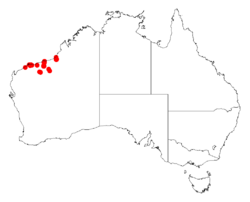Biology:Acacia glaucocaesia
| Acacia glaucocaesia | |
|---|---|
| Scientific classification | |
| Kingdom: | Plantae |
| Clade: | Tracheophytes |
| Clade: | Angiosperms |
| Clade: | Eudicots |
| Clade: | Rosids |
| Order: | Fabales |
| Family: | Fabaceae |
| Subfamily: | Caesalpinioideae |
| Clade: | Mimosoid clade |
| Genus: | Acacia |
| Species: | A. glaucocaesia
|
| Binomial name | |
| Acacia glaucocaesia Domin
| |

| |
| Occurrence data from AVH | |
Acacia glaucocaesia is a shrub or tree belonging to the genus Acacia and the subgenus Phyllodineae that is endemic to north western parts of Australia .
Description
The dense glabrous shrub or tree typically grows to a height of 1.8 to 6.0 metres (6 to 20 ft).[1] It has branchlets with a white powdery covering and spiny stipules on younger plants. The thin phyllodes are rarely green except on new shoots. The phyllodes have an elliptic to lanceolate shape and a length of 1.5 to 2.5 cm (0.59 to 0.98 in) and a width of 7 to 13 mm (0.28 to 0.51 in) and an inconspicuous midrib.[2] The plant blooms between from July to September and produces yellow flowers.[1] The inflorescences are spherical containing 35 to 50 pale yellow flowers. The seed pods that form after flowering have a narrowly oblong shape with a length of up to 4 cm (1.6 in) and a width of 12 to 13 mm (0.47 to 0.51 in) and have a powdery white covering. The shiny brown to black seeds within have an oblong to ovate shape and are 4 to 5 mm (0.16 to 0.20 in) in length.[2]
Taxonomy
The species was first formally described by the botanist Karel Domin in 1926 as part of the work Beitrage zur Flora und Pflanzengeographie Australiens as published in Bibliotheca Botanica. It was reclassified as Racosperma glaucocaesium by Leslie Pedley in 2003 then transferred back to the genus Acacia in 2006.[3]
Distribution
It is native to an area in the Pilbara and Kimberley regions of Western Australia where it is mostly found in floodplains growing in sandy, clay or loamy soils.[1] It is most commonly situated in the western Pilbara region mostly in between the De Grey River and Fortescue Rivers and forming dense monospecific stands.
See also
References
- ↑ Jump up to: 1.0 1.1 1.2 "Acacia glaucocaesia". FloraBase. Western Australian Government Department of Parks and Wildlife. https://florabase.dpaw.wa.gov.au/browse/profile/12673.
- ↑ Jump up to: 2.0 2.1 "Acacia glaucocaesia". World Wide Wattle. Western Australian Herbarium. http://worldwidewattle.com/speciesgallery/glaucocaesia.php. Retrieved 6 May 2019.
- ↑ "Acacia glaucocaesia Domin". Atlas of Living Australia. Global Biodiversity Information Facility. https://bie.ala.org.au/species/http://id.biodiversity.org.au/node/apni/2913363#names. Retrieved 6 May 2019.
Wikidata ☰ Q15287125 entry
 |

